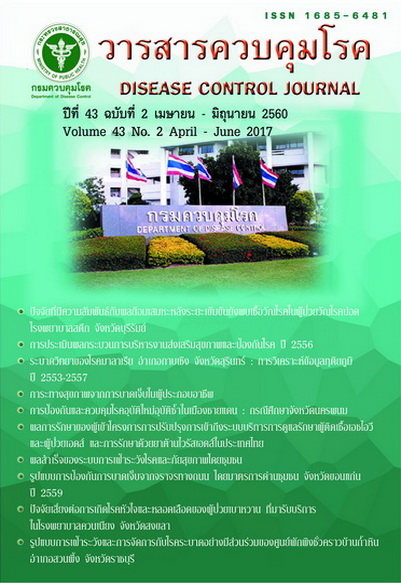Evaluation of the implementation of health promotion and disease prevention for the year 2013
DOI:
https://doi.org/10.14456/dcj.2017.22Keywords:
health promotion and disease prevention, evaluation, administrative processAbstract
This study is an evaluation of the administrative procedures for the implementation of health promotion and disease prevention by age group in the 1st - 12th service area during the fiscal year 2013. Its objectives were to evaluate the administrative procedures of health promotion and disease prevention, to determine the expectations for the strategic plans of health promotion and disease prevention in the next 10 years, and to determine both the key success factors for the implementation of health promotion and disease prevention and the required supports from the Ministry of Public Health and other organizations in order to achieve the desired goals. Qualitative data was obtained by analyzing the information in the reports of the evaluation of the implementation and the administrative processes of health promotion and disease prevention for the fiscal year 2013. Quantitative data was collected from questionnaires that were developed and suggested by the Ministry of Public Health’s inspector that is responsible for age group-related tasks and from the monitoring and evaluation specialist of the Department of Disease Control. The population and the sample group in the research were selected based on the so-called “purposive sampling” method then divided into 8 subgroups with a total of 117 members that came from the Department of Disease Control, the Department of Health, the Department of Medical Services, the Department of Mental Health, the Bureau of Inspection and Evaluation, academic centers, and provincial health offices. The study was conducted from September 2013 - January 2014. Overall, the administrative processes of the health promotion and disease prevention have clearly followed the policies set forth by the Ministry of Public Health. The required budget funding was allocated from the National Health Security Office, the Ministry of Public Health, provincial governments, and the Community Health Fund. Meetings among relevant participants were setup in order to clearly communicate the implementation plans, project objectives, and involved activities from the central and provincial level offices to the local level offices where the progress can be monitored and tracked by usual means, e.g. district supervisions or provincial meeting progress reports. The expectation for the strategic plans of health promotion and disease prevention in the next 10 years is to be able to reach an important goal that people in communities are free from diseases and health risks. This is to be achieved with the help of the information gathered from local needs, and the evaluations of the past project implementations in conjunction with the management integration among partnership networks. The success of the implementations of health promotion and disease prevention relies on the establishing of the following key factors: a combined executive committee and sub-committee command structure with members from top managements and scholars from every related academic department; having enough qualified operators who can translate the proposed plans into actions and also are able to effectively drive the operations to meet the set goals; and having support budget that is both sufficiently and timely available. Supports that are needed from the Ministry of Public Health are: communications that are clear, timely, and effective about policies and strategies; development of human capital that is capable of supporting the implementation of health promotion and disease prevention for each age group. These are to be supported by: an efficient information technology system; career path growth for personnel involved and appropriate compensations; clear and consistent evaluation practice with the goals of being able to utilize the concluded results in future projects. Because the current government put great emphasis on integration plan at the national level, ministries with ongoing projects that are interrelated must formulate their objective and budget allocation plans in a strategically integration manner. The human capacity integration plan for various age groups is a part of this adopted practice. Because the Health Ministry has set forth strategic plans for health promotion and disease prevention, it is a great opportunity to speed up the implementation. There should be some process to determine guidelines that show clear integration plan which is timely to the practice in the field. The suggestions of this current study were:(1) Establishing an executive committee with members from executives, specialists, and relevant parties to implement health promotion and disease prevention plans; (2) Planning and managing project budget in an integrated fashion among relevant parties with the help of health information data from local, regional, and national plans; (3) Communicating the established plans with related associates via appropriated channels, and (4) Fully engaging in the monitoring and the evaluation process then applying the results obtained in future development plans when possible.
Downloads
References
2. Carvalho SR, Compose GW. Health care models: organization of Reference Teams in the health basic network of Secretaria Municipal de Saude of Betim, Minas Greais State, Brazil. Cad Saude Publica 2000;16:507-15.
3. วิพุธ พูลเจริญ, สมศักดิ์ ชุณหรัศมิ์, สุวิทย์ วิบุลผลประเสริฐ, โกมาตร จึงเสถียรทรัพย์, จิรุตม์ ศรีรัตนบัลล์. สู่การปฏิรูประบบสุขภาพคนไทย. กรุงเทพมหานคร: ดีไซร์; 2543.
4. สำนักนโยบายและยุทธศาสตร์ กระทรวงสาธารณสุข. รายงานการศึกษาภาระโรคและการบาดเจ็บของประชากรไทย พ.ศ. 2547. นนทบุรี: สถาบันวิจัยระบบสาธารณสุข; 2550.
5. กระทรวงสาธารณสุข. คู่มือการประเมินกระบวนการบริหารงานส่งเสริมสุขภาพและป้องกันโรคของจังหวัด ปีงบประมาณ 2555. นนทบุรี: กระทรวงสาธารณสุข; 2555.
6. รักใจ บุญระดม, เกศรินทร์ ไทยศรีวงศ์, บัญชาพร้อมดิษฐ์, กุมารี ศรีจันทร์. การประเมินผลการดำเนินงานนโยบายสร้างสุขภาพจังหวัดจันทบุรี ตามโครงการเมืองจันท์สุขภาพดี. วารสารวิทยาลัยพยาบาลพระปกเกล้าจันทบุรี 2553;21:10-21.
7. ประภาส อนันตา, เสถียรพงษ์ ศิวินา, สำนักงานสาธารณสุขจังหวัดร้อยเอ็ด, โรงพยาบาลเกษตรวิสัย. รูปแบบการนำแผนเชิงกลยุทธ์ไปสู่การปฏิบัติของหน่วยบริการปฐมภูมิ อำเภอเกษตรวิสัย จังหวัดร้อยเอ็ด. วารสารสำนักงานป้องกันควบคุมโรคที่ 6 จังหวัดขอนแก่น 2556;20:9-18.
Downloads
Published
How to Cite
Issue
Section
License
Articles published in the Disease Control Journal are considered as academic work, research or analysis of the personal opinion of the authors, not the opinion of the Thailand Department of Disease Control or editorial team. The authors must be responsible for their articles.






